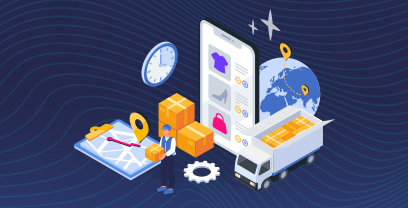Procurement management plays a critical role in helping organizations control spend, reduce risk, and build stronger supplier relationships. Yet for many organizations, procurement still runs on a patchwork of emails, spreadsheets, and outdated systems, making it difficult to control spend or respond quickly to shifting priorities.
An effective procurement management system creates structure from chaos and gives teams the visibility they need to make smarter, faster decisions.
In this guide, we look at the components of modern procurement management – the frameworks, essential tools, and real-world strategies that help optimize procurement processes.
Key Takeaways
- Effective procurement management requires a structured, end-to-end process supported by the right tools and workflows.
- Common challenges like maverick spend, supplier duplication, and audit gaps often stem from unstructured intake and can be resolved by using a centralized platform.
- Features such as role-based intake, contract lifecycle management, and integrated payment tracking are essential for organizations looking to scale procurement efficiently and strategically.
What Is Procurement Management?
Procurement management is the strategic process of how organizations plan, source, purchase, and oversee the goods and services they need to operate. It covers everything from choosing suppliers and negotiating contracts to tracking spend and making sure purchases follow company policies.
At its best, procurement management brings control and consistency to a process that can otherwise be messy. It helps teams avoid overspending, reduce risk, and make smarter budgetary decisions.
While it’s easy to confuse procurement with purchasing, they’re not the same.
- Purchasing is transactional and involves placing orders, receiving goods, and paying invoices.
- Procurement is more strategic – setting up the rules, workflows, and relationships that keep the entire buying process running smoothly and in line with business goals.
When procurement isn’t centralized, things can quickly get off track. Teams may place orders through email, manage vendors on spreadsheets, or buy tools without going through the proper channels.
These workarounds – sometimes called “shadow procurement” – lead to inconsistent pricing, the use of unapproved vendors, and a lack of visibility into what’s actually being spent. In such a scenario, money is wasted, and compliance is challenging.
That’s where strong procurement management makes a real difference. By replacing siloed sourcing and patchwork tools with clear processes and connected systems, you gain transparency and control, and it’s easier for everyone to follow the rules.
Let’s take a look at all of the procurement steps, and how they work together to secure the future of procurement.
The Procurement Management Process: Intake to Supplier Performance
Procurement management starts with intake and extends through supplier performance evaluation. Each stage requires clear processes, stakeholder alignment, and system support to avoid risk. If you lack a unified platform, you may face delays, maverick spend, and missed opportunities for cost savings.
Below, we walk through the 6 key steps in the procurement management process:
- Intake and Purchase Requisition
- Supplier Research and Selection
- Contract Negotiation and Compliance
- Purchase Order Creation and Approval
- Invoice Matching and Payment
- Supplier Performance and Renewal
Intake and Requisition Approval
Intake sets the tone for the entire procurement lifecycle. When intake is informal or disconnected from procurement, it’s almost impossible to enforce policies or prioritize strategic sourcing.
A lack of structure leads to delays and blind approvals that have a negative impact on budget and compliance. Indirect spend categories such as consulting, IT, and legal are especially prone to maverick spend if not guided through proper intake.
Read our blog to learn more about direct vs. indirect procurement.
By contrast, a centralized intake workflow ensures requests are captured in a system that routes them automatically based on department, budget owner, and category. Many centralized platforms offer AI-powered classification that helps auto-categorize vague or inconsistent requests based on historical patterns, greatly reducing manual triage and ensuring routing rules are followed from the start.
Supplier Research and Selection
The next step is vendor selection. When suppliers are evaluated and selected in a decentralized manner, supplier vetting is inconsistent and risky. You will also miss out on opportunities to leverage negotiated contracts.
Procurement teams benefit from tools that centralize supplier data, qualifications, and historical performance to streamline vetting and reuse. Centralized systems offer curated supplier catalogs, search filters for compliance certifications, and automated alerts for expired documents, ensuring sourcing stays strategic and auditable.
Contract Negotiation and Compliance
Negotiating and finalizing contracts requires involvement from a wide array of stakeholders across N legal, finance, and procurement. However, when contracts are managed through email or stored locally on desktops or shared drives, you end up with version control issues, delayed approvals, and compliance risks.
Procurement platforms help streamline this process with clause libraries, contract templates, and automated workflows for reviews. These tools help to standardize terms and trace approvals and obligations efficiently.
Purchase Order Creation and Processing
Purchase order creation is another stage prone to breakdowns, especially when approvals are captured informally, for example, in Slack threads, email chains, or spreadsheets. These ad hoc methods often miss critical policy checks and leave no audit trail.
For example, an HR team might approve a training expense through a Slack poll but fail to log the spend, causing reconciliation issues later.
A unified system allows for guided buying, pre-approved catalogs, and automated PO workflows tied to budget and contract terms.
Invoice Matching and Payment
After delivery, suppliers submit invoices, which must be matched against POs and receipts. This “three-way match” is essential for preventing overpayment, fraud, or duplicate invoices. Unfortunately, the process can be very manual if your systems aren’t integrated.
This can introduce a wide range of risks. For example, say a supplier sends two versions of an invoice. Without procurement automation, both might be paid.
Unified procurement platforms prevent this by enforcing controls and maintaining real-time visibility across purchasing and finance. Automation accelerates matching, discrepancy flagging, and vendor payment processing, and when AP systems are integrated, there are fewer payment errors and you have better cash flow management.
Supplier Performance and Renewal
Without centralized tracking, feedback is anecdotal and supplier evaluations can be reactive. Procurement teams need structured scorecards, KPIs, and renewal thresholds to track delivery, quality, and responsiveness over time.
For example, repeated shipping delays from a packaging supplier may go unnoticed until they impact operations. If you have a system that logs incidents, tracks SLA compliance, and flags renewal decisions accordingly, you have greater accountability in supplier relationships.
AI-Powered Intake Classification
Many procurement teams now use AI to classify incoming requests automatically. AI can interpret vague descriptions such as “need help with marketing” or “renew tech tool,” and assign the appropriate category, budget owner, or sourcing path based on historical patterns.
For example, AI can recognize that “new email platform” should be categorized under IT software, triggering required security checks and routing to the appropriate stakeholders. This reduces manual review while minimizing policy violations.
Together, these stages form a connected, intelligent procurement process that helps turn procurement from a tactical function into a strategic one. Let’s examine what that means in greater detail.
Strategic vs. Tactical Procurement
Modern organizations are shifting from transactional, short‑term procurement toward a strategic, value-driven model. The table below contrasts both approaches across five key dimensions.
| Dimension | Strategic Procurement | Tactical Procurement |
| Ownership | Led by cross-functional teams with procurement, finance, and category managers at the helm Gep+8Veridion+8ProcureAbility+8Ivalua. | Handled by operational staff or individual departments without formal procurement oversight. |
| Time Horizon | Long-term focus on total cost of ownership, value creation, and innovation . | Short-term, reactive buying focused on immediate needs—“spot buys” and price only . |
| Supplier Relationships | Emphasises deep partnerships, risk management, supplier development . | Transactional, limited interaction, and minimal vetting or collaboration. |
| Data Use | Advanced analytics, spend management and visibility, supplier performance and risk data . | Basic price comparison, ad hoc quotes, minimal spend tracking. |
| Success Metrics | KPIs include TCO reduction, supplier innovation, risk resilience, stakeholder alignment . | Metrics focus on cost savings per transaction or speed of fulfilment. |
According to Ivalua and leading analysts, high-performing organisations invest in technologies such as Source‑to‑Pay platforms, advanced spend analysis, and supplier scorecards to operationalise procurement strategy and move away from reactive purchasing.
With the right technology, governance, and data, procurement can be a strategic growth driver. In fact, a recent Ivalua report on purpose-driven procurement highlights how shifting the balance toward strategic sourcing can improve compliance, create value, and increase agility.
While the shift to strategic procurement offers clear long-term value, making that transition isn’t always easy, and many organizations still face significant challenges that hinder effective procurement management.
Common Procurement Management Challenges
If your procurement process feels chaotic, reactive, or costly, you’re not alone. Many organizations experience recurring issues that undermine control and compliance.
These problems often share a common root cause: fragmented or informal intake. Without a unified way to capture, route, and manage procurement requests, maverick spend, inconsistent approvals, and audit gaps may be the norm.
Take a look at the table below. Do any of these challenges resonate with you?
| Challenge | Impact | Stakeholder Example | How to Solve It |
| Maverick Spend | Increased costs, compliance risk, poor supplier leverage | A marketing team hires an agency outside of procurement and pays above rate | Centralize intake with guided request workflows and preferred vendor lists |
| Supplier Duplication | Disjointed contracts, payment delays, and missed volume discounts | AP receives invoices from two vendor profiles with slightly different names | Consolidate intake and connect to a single supplier master database |
| Inconsistent Approvals | Policy violations, missed budget checks, approval delays | A department lead approves a tool in Slack with no formal PO | Implement intake forms with automated routing based on role, category, and budget thresholds |
| Missed Savings | Lost opportunities for negotiation and bundling | IT buys a SaaS license that procurement already negotiated at a lower price | Triage all requests through procurement early using structured intake forms |
| Audit Gaps | Incomplete documentation, increased audit exposure | Finance can’t trace why or how a vendor was selected | Use integrated intake-to-contract systems that log approvals and sourcing rationale automatically |
If you look at the solution column, you’ll find that unstructured intake is the silent culprit behind most of these challenges. It prevents procurement teams from influencing key decisions early, limits visibility into demand, and creates downstream reconciliation hurdles.
By capturing every request in a single, centralized platform, you’ll be better positioned to enforce policies and improve collaboration across the procurement lifecycle.
Now that you understand how to tackle these common challenges, the next step is knowing what to look for in a procurement software that can address them effectively.
What To Look For In Procurement Management Software
In a decentralized organization, managing procurement without the right tools can quickly lead to confusion, compliance issues, and missed savings. That’s why choosing a procurement platform with the right core features is essential.
The tools and capabilities listed below are must-haves for ensuring consistency, visibility, and control across the entire procurement process.
Role-based Intake Workflows
Procurement begins with intake management, so your platform must support structured request forms with automated routing based on department, category, and budget owner. This ensures compliance from the first step and prevents unapproved spend or disconnected purchases made over email or Slack.
Supplier Data Centralization
A single, clean supplier database is essential to avoid duplication, payment errors, and risk. Look for systems that unify supplier data across sourcing, contracting, and invoicing, so you aren’t sourcing from incomplete or outdated records.
Contract Lifecycle Tools
Managing contracts via shared drives or inboxes creates compliance and renewal risks. Procurement software should include version-controlled templates, automated workflows for review and approvals, and clause libraries to standardize terms while speeding up negotiations.
ERP/AP Integrations
To prevent duplicate payments, reconciliation delays, and reporting blind spots, seamless integration with ERP and Accounts Payable systems is critical. Procurement must tie into financial systems to track budget impact and streamline invoice processing.
Audit-ready PO-to-Payment Tracking
Your software should maintain a complete, traceable record from purchase request to payment, to support compliance audits and enable continuous improvement.
Together, these features form the foundation of scalable, modern procurement.
For a solution that meets all of these needs—and has been recognized by analysts as a leader—explore Ivalua’s Procurement Platform and the 2025 S2P Gartner Magic Quadrant report.
Download the latest 2025 Gartner Magic Quadrant Source-to-Pay Suites report to find out why Ivalua was recognized as a leader.
Now let’s review how one company is addressing their intake challenges with Ivalua.
Case Study: Fixing Intake Chaos and Enabling Scalable Procurement
Körber, a global supply chain and manufacturing company restructured their approach to Procurement using Ivalua’s unified Source-to-Pay platform.
Before procurement transformation, the company’s decentralized procurement environment made it difficult to enforce policy, manage supplier data, or track spend holistically. Intake was informal and often bypassed procurement, leading to maverick spend and missed savings opportunities.
Additionally, sourcing events were manual in nature and contracts were stored inconsistently, with no shared system for tracking terms or renewals.
With Ivalua, Körber was able to centralize intake, giving stakeholders structured request forms with built-in routing based on role, category, and budget. This simple change immediately improved visibility and control.
They also automated sourcing workflows and contract lifecycle management, reducing cycle times and ensuring that compliance guardrails were in place.
Körber also launched an AI pilot with the goal of reducing manual work and supporting smarter, policy-aligned intake decisions. They combined this with clear internal controls to ensure ethical and business-led use of AI, reinforcing trust and accountability.
With a unified platform in place, Körber now operates with greater consistency, better data, and the ability to grow without adding complexity. Read the full Korber case study.
Take the Complexity Out of Procurement Management
Managing procurement doesn’t have to be complicated. With the right tools in place, you can bring structure to every step – from intake to supplier performance – while improving visibility, reducing risk, and making it easier for teams to follow the process.
See how Ivalua’s unified procurement platform can help you simplify and scale procurement across your organization.
FAQ: Procurement Management for Enterprise Teams
What is procurement management in simple terms?
Procurement management is the process of sourcing, purchasing, and managing the goods and services a business needs to operate. It involves setting policies, approving requests, working with suppliers, and making sure spending is controlled and aligned with company goals. When done well, it helps reduce costs, ensure compliance, and build better supplier relationships.
What are the key steps in the procurement process?
The procurement process typically includes intake management and purchase requisition approval, supplier selection, contract negotiation, purchase order creation, invoice payment, and supplier performance tracking. Each step plays a role in making sure the right products or services are bought at the right price and under the right terms. Centralized systems help ensure consistency and visibility across these stages.
What is the difference between procurement and purchasing?
Procurement is the broader, strategic process that includes sourcing, managing suppliers, and setting policy. Purchasing is the transactional part, which includes placing orders, receiving goods, and paying invoices. Procurement sets the direction, while purchasing carries it out.
How can businesses reduce procurement costs?
One of the most effective ways to reduce costs is by centralizing intake and sourcing through a single platform. This helps eliminate maverick spend, take advantage of negotiated contracts, and avoid duplicate suppliers. It also improves forecasting and allows procurement to be more proactive.
What should I look for in procurement software?
Look for a procurement software that supports role-based intake workflows, centralized supplier data, contract lifecycle management, ERP/AP integration, and audit-ready PO-to-payment tracking. These features help ensure compliance, reduce risk, and make the entire process more efficient. Platforms like Ivalua offer all of these capabilities in one place, making it easier to manage procurement at scale.




